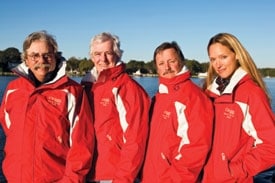
JanBOTYJudgesSt
Mention to pals that you’re heading to Annapolis to look at 23 cruising sailboats-and to spend another four days sailing them-and you don’t get a lot of sympathy. But truth be told, it’s a lot like work.
The Cruising World Boat of the Year program begins with a survey of boat manufacturers worldwide asking about new models. From the 61 sailboats we uncovered this year, we then invited those builders planning to attend the U.S. Sailboat Show to enter the BOTY contest. About three dozen took us up on the offer, and these boats were visited during the Newport International Boat Show and prior to the opening of the show in Annapolis by three preliminary judges: John Burnham, CW’s editor, Tim Murphy, a CW editor at large and co-director of this year’s BOTY contest, and full-time cruiser Skip Moyer, a retired U.S. Navy officer and a former president of the American Boat & Yacht Council. Their dockside inspections whittled down the field so that in the end, the BOTY judges had 23 sailboats to consider.
The 2007 BOTY judges included Stacey Collins, a lifelong cruiser who served as a consumer representative on the panel; Ed Sherman, a systems expert and curriculum developer for ABYC; world cruiser, adventurer, and author Alvah Simon, who looked at safety issues and how the boat’s gear was laid out; and Peter Wormwood, a sailboat designer, manufacturer, and multihull racer.
Beginning at 8:30 a.m. on the Friday of sailboat-show weekend in Annapolis, the judges visited six sailboats a day, rain (it did) or shine until the show wrapped up on Monday. Along the docks, a “Judging in Process” banner would announce their presence on a sailboat, which the builder closed to the public for more than an hour while the four went to work crawling into bilges, lockers, and engine rooms and inspecting behind electrical panels. Stacey assessed livability, and Ed reviewed systems. Alvah spent a lot of time on deck looking for sharp edges, troublesome line leads, and obstructions that could pose problems in harsh conditions at sea. Peter inspected such construction details as woodwork joinery, the hull/deck joint, bulkhead tabbing, and hull grids.
And then on Tuesday, they started all over again; up at 6 a.m., on the dock by 8 a.m., waiting to be taken by inflatable to the first test sail at 8:30. They spent more than an hour on each boat out on the Chesapeake. They raised, lowered, and furled six suits of sails a day and assessed performance while closehauled and off the wind. Under power, sound levels were determined below and handling characteristics were assessed while backing down. Six anchors were lowered and raised each day to gauge how well bow rollers and windlasses worked.
When they came off the water each evening, the real work began as they reviewed notes and summed up their views of each boat tested that day.
By Thursday, some of the six category winners began to emerge, and by midevening on Friday, Day Eight, all of the winners had been picked. Then it was down to the nitty-gritty work of choosing the Domestic Boat of the Year and the Import Boat of the Year.
Tough work. Fortunately, we had some good judges to do it.








